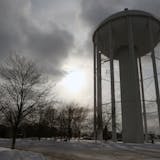"We were going along and then suddenly, this," the woman said, her hand mimicking a plane gliding through the air at shoulder level, before dropping dramatically to near her waist. "I was a mess."
I overheard the conversation at a sports club and quickly discerned that she was a wary flier and her friend was just the right person for her story: He is a pilot. Having recently endured my own bumpy airplane ride, my ears perked up.
"I'll say this. We pilots are a selfish bunch," he said. "We wouldn't do anything to put ourselves in harm's way, and the rest of the people sitting behind us benefit from that."
The line sounded like one the guy has uttered many times. But then something else he said seemed more off-the-cuff and reassuring — perhaps because it is based on hard evidence rather than squishy human behavior.
An airplane's wings are meant to give — a little or a lot, depending on the conditions in the air. In fact, they can bend more than 45 degrees without breaking, he said.
I left my eavesdropping session a little less leery of turbulence and a lot more curious about how airplanes and their thin arms manage choppy air.
Turns out that wings are very strong, and they go through rigorous tests to prove it.
As part of the vetting process for any new aircraft design, the wings are bowed and flapped almost to the breaking point by oversized robotic arms. They are repeatedly jostled and twisted and subjected to pressure as part of a test of their endurance. (Check it out yourself with a series of Popular Mechanics videos at tinyurl.com/hjelvzn.) Planes are tested with gushing water, lightning strikes and dead chickens shot at their engines to mimic a flock of birds. And then purposefully flown into harsh conditions.
![A black bear stopped after crossing Big Bay Road on Madeline Island, the largest of the Apostle Islands in Wisconsin, on Monday, May 31, 2021. ]](https://arc.stimg.co/startribunemedia/PWNYGIY3WTSWDBOGOYD775DPP4.jpg?&w=80&ar=1:1&fit=crop)


